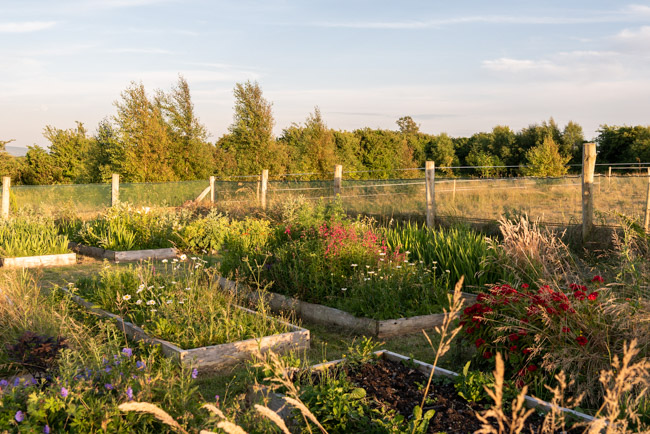The Burren Flower Farm
Buying or gathering flowers can feel like a luxury. In a practical sense, they have no use. But as Michael Longley has said about poetry, that’s not to say they are without value.
The Burren region on the west coast of Ireland has a wild, bleak, even surreal, landscape of limestone. At a distance its twisted, glaciated hills can look like smooth silvery mud pies. When you get closer however, its limestone karst terraces are punctuated by woodland of hazel, ash and birch, which provide a haven for lichen and ferns, along with wildlife from birds of prey to butterflies, bats, pine martens and even wild goats. At your feet are tiny wildflowers, ferns and grasses emerging from the limestone’s grikes. Alpine, Mediterranean and arctic plants grow side by side because of the region’s unusual geology and history.
It’s a place unlike anywhere else I know – mystical, fragile and full of vitality all at once.
The Burren Flower Farm is a microcosm of this landscape: surrounded by those unmistakeable hills and with its own limestone pavement, native woodland, turlough and meadows.
Originally bought as a tranquil place to live while working nearby, over time founder Sarah Wall has drawn on her background in forestry, ecology and gardening to create a home and a living on the land.
I had been attracted to Sarah’s work for its colour and rambling textural beauty, and the way it reflects the particular season and place through an intelligent and creative mix of cultivated, native and wild flowers, along with herbs, grasses and branches that thrive in the Burren.
I visited the farm one evening during the recent heat wave, when it had cooled enough for Sarah to show me around the property and to cut flowers for the next day’s deliveries.
As we walked around, Sarah explained how the landscape and seasons offer both creative inspiration and constraint. Because she works with what she has available on the property, Sarah is careful to make the most of her cultivated flowers and be open minded about the wildflowers and foliage available to her. She cultivates her flower beds in stages to generate a constant supply and variety for her arrangements, as well as continuous cover to control weeds naturally.
Like all types of farming however, things often don’t go to plan. The first half of this year alone has brought extremes from the cold and snow of Storm Emma to the recent heat wave and drought.
These challenges mean that Sarah also relies on foraging to supplement her cultivated flowers. Out of necessity, she takes a holistic view of her environment, but it is this perspective that also highlights its beauty and diversity. Through Sarah's eyes, the gentle wave of grasses call to be included in her arrangements, and the architectural qualities of young hazel and birch branches become a complement to the elegance of tulips.
Sarah also sees weeds in a different light. It's a reminder that the term doesn't have any botanical significance, and really refers to a plant that is undesirable in a particular location. But that doesn't mean that weeds can't be appreciated for their own kind of beauty and place in the landscape.
Like her arrangements, Sarah’s management of the property balances the cultivated, wild and native. She allows nature to do its work in the meadows and limestone pavement areas where cattle previously grazed, as is traditional in much of the Burren. Over her 13 years on the farm, the woodland has naturally expanded from a single large birch tree to over 40 trees.
There is some debate about hazel scrub and woodland covering areas of limestone where the Burren’s renowned flora otherwise bloom. Sarah’s counterpoint to this is to recognise that woodland is also part of nature and that native woodland and lichen are equally important as the flowering herbaceous, and can be managed where needed.
Sarah's blend of creativity and invention ensures that her arrangements are always unique and reflect what is flowering on her farm and in the Burren at that particular time. It’s not an easy balance to strike and many people wouldn’t bother, especially with the flower industry shipping flowers from all over the world these days to guarantee supply at any time of the year. But for me, and many others, this dedication matters.
My time with Sarah helped me to appreciate that being in the presence of her beautiful flowers has the power to enliven and bring us more into rhythm with the natural world.
We can enjoy flowers in the wild but we can also find great delight in giving or receiving an arrangement that has been grown and gathered into something new and perhaps even surprising.
They help us to value what is fleeting and fragile. They remind us that even in the greatest bleakness, we can be elevated and sustained by everyday beauty. And that has real value.
Sincere thanks to Sarah for so warmly and generously inviting me to the Burren Flower Farm and into her creative process in those gorgeous golden hours of sunset. It's an experience I'll never forget.
You can follow Sarah's work on Instagram and if you’re lucky to be in the Burren on a Friday, go and buy some flowers at the Kinvara Farmers’ Market. They’ll be sure to brighten your day.






















